From Sea to Shining Sea: Sailing in Place
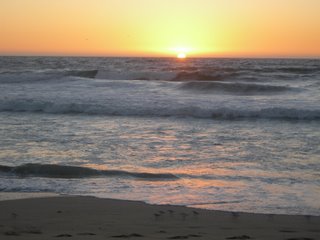
The sun sets across the dunes. The beach is nearly deserted, but the curve of Monterey Bay reveals city lights beginning to twinkle in the distance. This is Marina Dunes,California and my view out into the white caps accompanied by the strange music of screeching gulls begs me to look back at the western half of the continent that I have just slipped across like a sea passage.
When I left Chadron in far western Nebraska, the air was cold and the snow was falling. By the time I got fifty miles into Wyoming, the horizon had grown demonstrably, and the temperature began to rise. Following the railroad line, I could see that towns grew because of the train and were now dying because the train wasn’t stopping in so many places anymore. Larger settlements had shrunk, smaller settlements had disappeared.
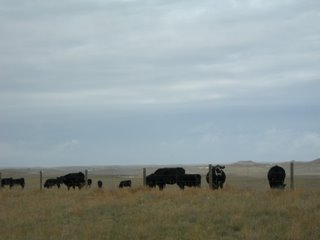 In every direction, there were vast high plains with cattle and the infrequent but distinctly marked entrances to ranches. The town of Lusk seemed prosperous and healthy with its own Carnegie Library and lots of bustle.
In every direction, there were vast high plains with cattle and the infrequent but distinctly marked entrances to ranches. The town of Lusk seemed prosperous and healthy with its own Carnegie Library and lots of bustle.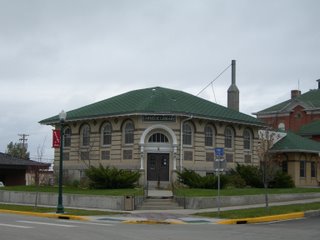 As I headed southwest, the temperature rose and as I slowly veered west, the mountains emerged in the distance. River valleys were green and there were wild turkeys, antelope and deer visible in the landscape. The sky was getting sunny, and the mountain pass was narrow and winding although not particularly high at 5200 ft. The rest of
As I headed southwest, the temperature rose and as I slowly veered west, the mountains emerged in the distance. River valleys were green and there were wild turkeys, antelope and deer visible in the landscape. The sky was getting sunny, and the mountain pass was narrow and winding although not particularly high at 5200 ft. The rest of 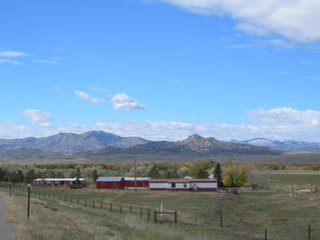 Wyoming was scrubby desert with lots of sagebrush and infrequent towns. The entrance into Utah was spectacular with red outcroppings and a huge descent into the Salt Lake Valley.
Wyoming was scrubby desert with lots of sagebrush and infrequent towns. The entrance into Utah was spectacular with red outcroppings and a huge descent into the Salt Lake Valley.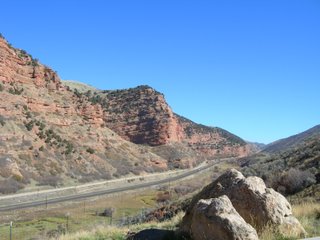 Salt Lake City was clean and very orderly, and as I made my way west skirting the south shores of the Great Salt Lake, there were several salt processing facilities with the Morton Salt Girl trademark beaming forth boldly.
Salt Lake City was clean and very orderly, and as I made my way west skirting the south shores of the Great Salt Lake, there were several salt processing facilities with the Morton Salt Girl trademark beaming forth boldly.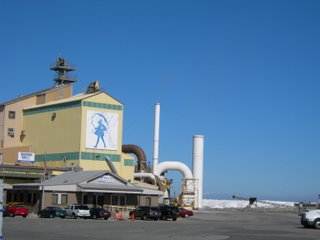 As I passed from West Wendover, Utah to Wendover, Nevada, the contrast was striking. West Wendover was sedate and rather dour with its churches and quiet cafes, while Wendover was bodaciously brilliant with its strip of enticements for gambling, girls, and feasts of all sorts- a jolly juxtaposition of disparate approaches to ecstatic experience.
As I passed from West Wendover, Utah to Wendover, Nevada, the contrast was striking. West Wendover was sedate and rather dour with its churches and quiet cafes, while Wendover was bodaciously brilliant with its strip of enticements for gambling, girls, and feasts of all sorts- a jolly juxtaposition of disparate approaches to ecstatic experience.Nevada was amazing. Very dry and vast with so many mountains in every direction, it was a wonderland, other-worldly, but comforting in its quiet and unhindered horizons. Towns now seemed to wear their casinos like gas stations or fast food outlets, just part of the mix. Elko, Winnemucca, Lovelock- all had somehow integrated the “sin” industry into the larger fabric of the greater community life. Each town had its distinctions, Winnemucca its Western Heritage Museum, Basque flavor, and a possible connection to Butch Cassidy; Lovelock, seat of Humboldt Co., had one of only two round courthouses in the U.S.
 Through extensive irrigation, this is the alfalfa seed capital of the U. S., and the county is proud of its locally developed burrowing bees that pollinate the alfalfa crop. These towns, surrounded by miles and miles of open country, have, out of necessity, developed distinct personalities as places as they have struggled with the beautiful but often inhospitable environment of the Great Basin.
Through extensive irrigation, this is the alfalfa seed capital of the U. S., and the county is proud of its locally developed burrowing bees that pollinate the alfalfa crop. These towns, surrounded by miles and miles of open country, have, out of necessity, developed distinct personalities as places as they have struggled with the beautiful but often inhospitable environment of the Great Basin.Climbing the mountains by Reno, Nevada means that California is over the ridge. Entering the Golden State on the old Truckee Trail is like a luge ride from 7000 ft to sea level when you finally approach the Pacific coast where again, traffic snarls, Targets and Wal-Marts decorate exit after exit, and theme-based sub-divisions crowd together, mile after mile- hopeful enclaves in service to the good life and the American Dream and then, of course, there’s the sea.
Way back in Nebraska, Mari Sandoz had lived her young years in a sea of grass. “About a quarter of Nebraska, 19,600 square miles, is covered by the Sand Hills, so called because the hills are entirely made of sand. The Sand Hills are Pleistocene sand dunes derived from glacial outwash from the Rockies, and now (mostly) stabilized by vegetation. (Dutch, “Nebraska Sand Hills.” P.1)
This vast unsettled area attracted Mari’s Swiss father. His lack of luck in love meant that by the time Mari was born, he was in his mid-forties with a permanent physical injury, married to his fourth wife, with irrepressible optimism about the potential for this vast untamed area and little interest in doing the everyday work of the farm. He hated fiction, saw it as the fodder of the lower class, and Mari had to hide her books in her straw mattress. Yet, Mari, for all of her early years, was an author in the making. She wrote 85 short stories, all of them rejected and when she had lost hope that any of her books would ever be published, she burned her stories and went back to the Sand Hills. It was only then that she learned that her book about her father, Old Jules, had been accepted for publication. In this book, which through the advice given in her many rejection letters, had been revised multiple times, she tried to capture both the brutality and beauty of her father and the place that she called home. She said of her father that “here was a character who embodied not only his own strengths and weaknesses but those of all humanity- that his struggles were universal struggles and his defeats at the hands of his environment and his own insufficiencies were those of mankind; his tenacious clinging to his dream the symbol of man’s undying hope that over the next hill he will find the green pastures of his desire. Further, I looked about me in life and in history and literature and I saw there were two kinds of men, the defeated and the undefeated, and that surely the last was the first.” (Sandoz, Hostiles and Friendlies, (p. xviii)
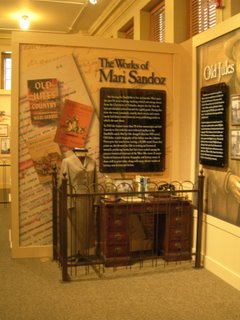
In writing her own story about her father and growing up, Sandoz captured the very essence of early Nebraska. Much like Cather in her admiration/criticism of the Nebraska trailblazers like her father, Sandoz once told a friend: “I consider Old Jules not so much a pioneer as a frontiersman. And he was that. He had the skill, the violence and the courage to cope with the unknown elements of a wild country; but not the patience for the dull road of the pioneer.” That Mari Sandoz understood and shared not just this personal revelation but a lifetime of stories and research that will forever illuminate the lives of the disparate people who settled, suffered, and grew in this distinctive place is certainly a fine and noble achievement. Her future is assured by the opening of the Mari Sandoz High Plains Heritage Center at Chadron State College, a learning center for the study of Nebraska and High Plains culture, literature, and history. As a meticulous researcher and a lover of good stories especially of the people from the Sand Hills, Mari Sandoz would be pleased.
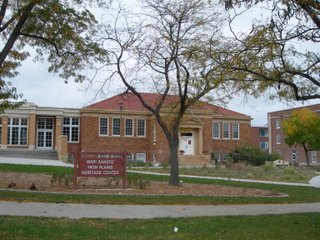
Deep in the desolate and undulating hills south of Gordon, Nebraska on the last homestead of Jules Ami Sandoz and Mary Elizabeth Fehr, is the grave of Mari Sandoz. While she spent her last twenty years living in New York and writing the rest of her twenty two works on Nebraska life, when all was said and done, she returned to her first and now her final home in the Sand Hills.
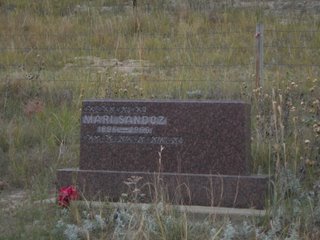 On a marble bench outside the Sandoz High Plains Center is the following inscription:
On a marble bench outside the Sandoz High Plains Center is the following inscription:“Our place is our origin, starting point, and center to which we return when adrift.
Place is our bank of daffodils.
(Andrew Elkins, Teacher and Scholaar, Chadron State College, 1981-2000.)
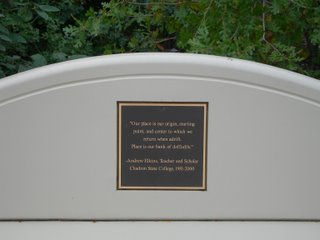

0 Comments:
Post a Comment
<< Home